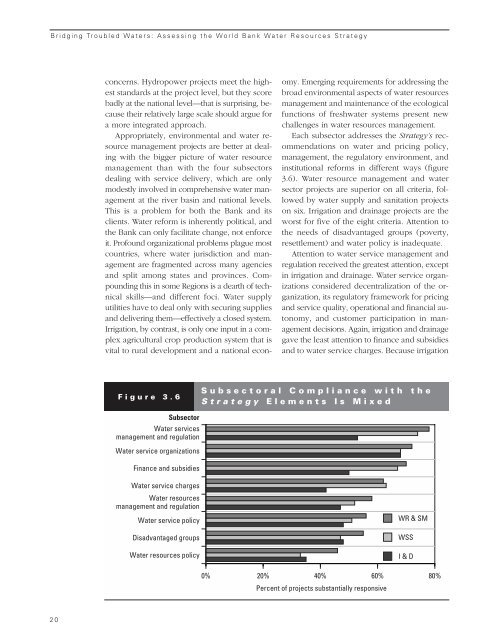Download Report - Independent Evaluation Group - World Bank
Download Report - Independent Evaluation Group - World Bank
Download Report - Independent Evaluation Group - World Bank
Create successful ePaper yourself
Turn your PDF publications into a flip-book with our unique Google optimized e-Paper software.
Bridging Troubled Waters: Assessing the <strong>World</strong> <strong>Bank</strong> Water Resources Strategyconcerns. Hydropower projects meet the higheststandards at the project level, but they scorebadly at the national level—that is surprising, becausetheir relatively large scale should argue fora more integrated approach.Appropriately, environmental and water resourcemanagement projects are better at dealingwith the bigger picture of water resourcemanagement than with the four subsectorsdealing with service delivery, which are onlymodestly involved in comprehensive water managementat the river basin and national levels.This is a problem for both the <strong>Bank</strong> and itsclients. Water reform is inherently political, andthe <strong>Bank</strong> can only facilitate change, not enforceit. Profound organizational problems plague mostcountries, where water jurisdiction and managementare fragmented across many agenciesand split among states and provinces. Compoundingthis in some Regions is a dearth of technicalskills—and different foci. Water supplyutilities have to deal only with securing suppliesand delivering them—effectively a closed system.Irrigation, by contrast, is only one input in a complexagricultural crop production system that isvital to rural development and a national economy.Emerging requirements for addressing thebroad environmental aspects of water resourcesmanagement and maintenance of the ecologicalfunctions of freshwater systems present newchallenges in water resources management.Each subsector addresses the Strategy’s recommendationson water and pricing policy,management, the regulatory environment, andinstitutional reforms in different ways (figure3.6). Water resource management and watersector projects are superior on all criteria, followedby water supply and sanitation projectson six. Irrigation and drainage projects are theworst for five of the eight criteria. Attention tothe needs of disadvantaged groups (poverty,resettlement) and water policy is inadequate.Attention to water service management andregulation received the greatest attention, exceptin irrigation and drainage. Water service organizationsconsidered decentralization of the organization,its regulatory framework for pricingand service quality, operational and financial autonomy,and customer participation in managementdecisions. Again, irrigation and drainagegave the least attention to finance and subsidiesand to water service charges. Because irrigationFigure 3.6Subsectoral Compliance with theStrategy Elements Is MixedSubsectorWater servicesmanagement and regulationWater service organizationsFinance and subsidiesWater service chargesWater resourcesmanagement and regulationWater service policyDisadvantaged groupsWater resources policyWR & SMWSSI & D0% 20% 40% 60% 80%Percent of projects substantially responsive20
















